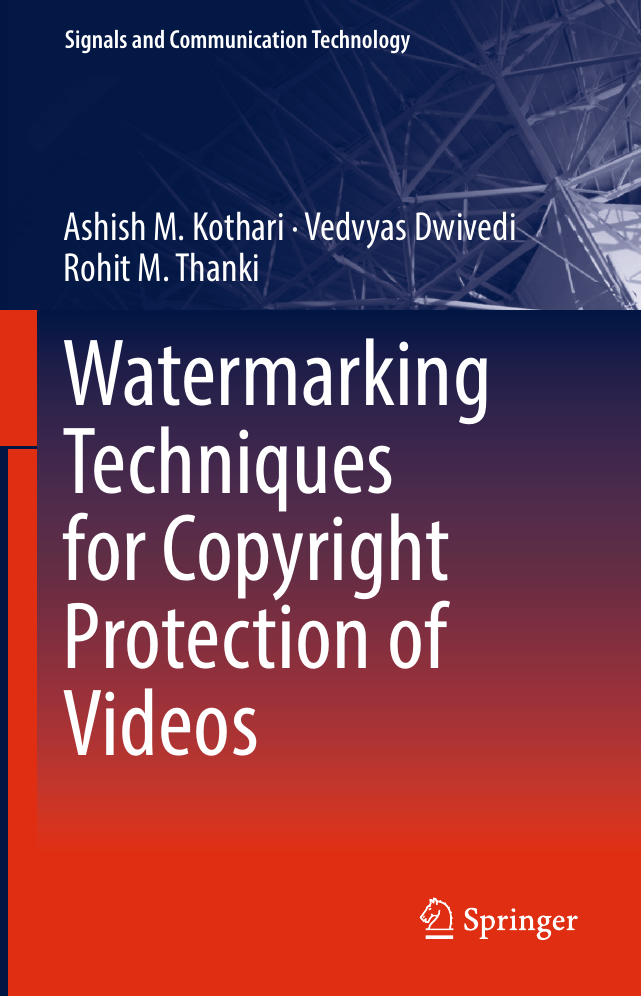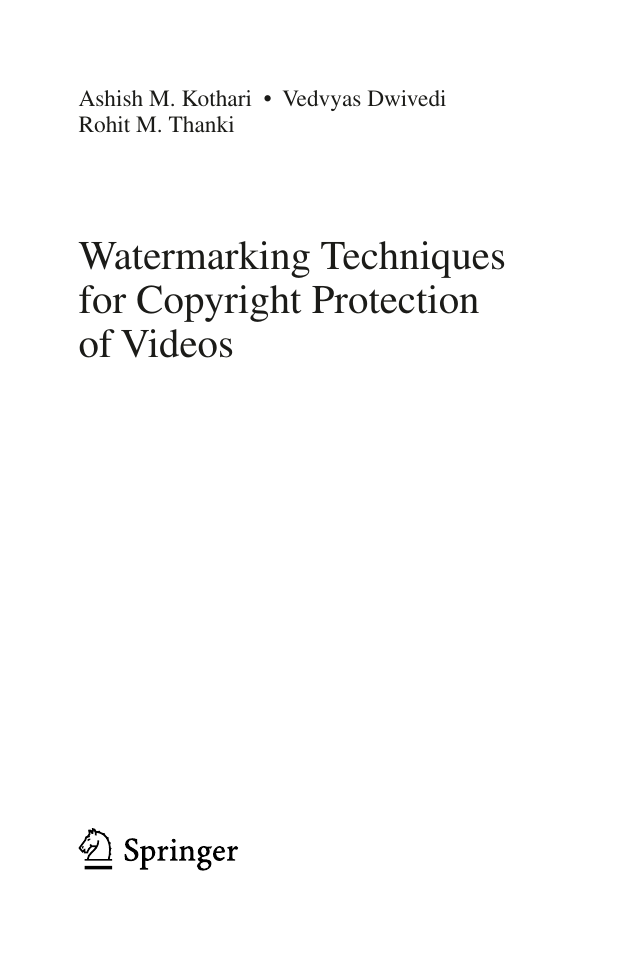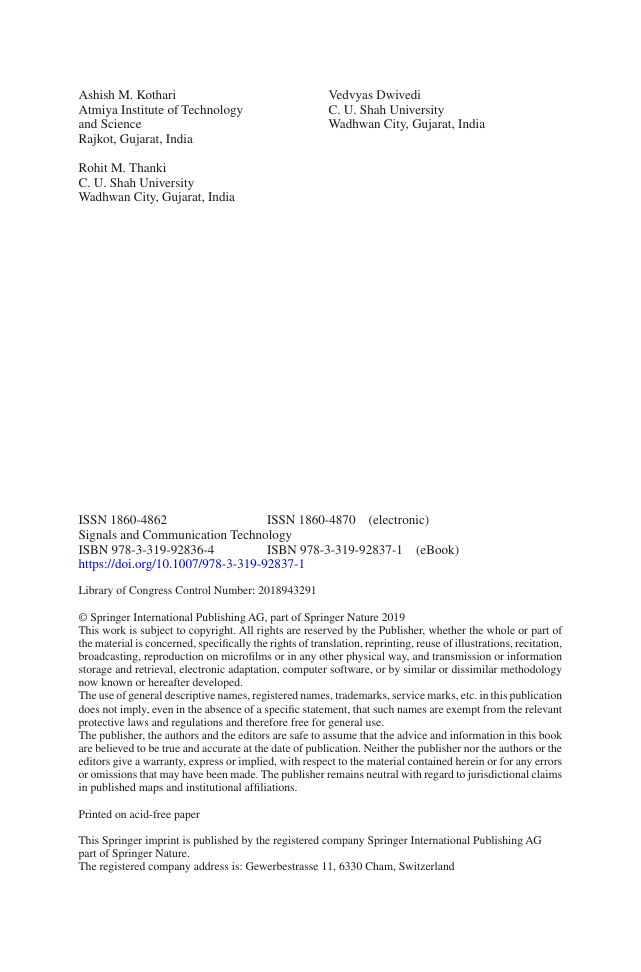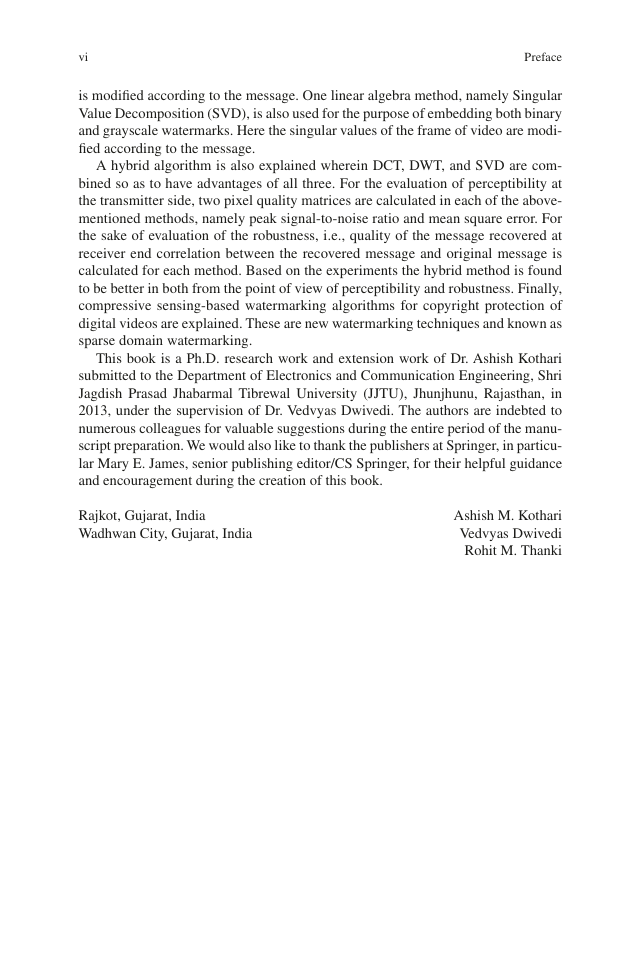Preface
Contents
List of Figures
List of Tables
Chapter 1: Introduction
1.1 Prologue
1.2 Basic of Watermarking
1.3 Requirements of Watermarking
1.3.1 Types of Watermarking
1.3.2 Applications of Watermarking
1.4 Watermarking Attacks
1.5 Quality Measures for Watermarking
1.6 Colorspace Conversion
1.7 Related Works to Video Watermarking
1.8 Book Organization
Bibliography
Chapter 2: Video Watermarking in Spatial Domain
2.1 Visible Watermarking
2.2 Invisible Watermarking
2.2.1 Least Significant Bit Substitution Approach
2.2.1.1 Watermark Embedding Process
2.2.1.2 Watermark Extraction Process
2.2.1.3 Experimental Results
2.2.1.4 Observation on Obtained Results
2.2.2 Correlation-Based Approach
2.2.2.1 Watermark Embedding Process
2.2.2.2 Watermark Extraction Process
2.2.2.3 Results of Imperceptibility Test
2.2.2.4 Results of Robustness Test
2.2.2.5 Observation on Obtained Results
Bibliography
Chapter 3: Video Watermarking in Transform Domain
3.1 Discrete Cosine Transform (DCT)-Based Approach
3.1.1 Watermark Embedding Process
3.1.2 Watermark Extraction Process
3.1.3 Results of Imperceptibility Test
3.1.4 Results of Robustness Test
3.1.5 Observation on Obtain Results
3.1.6 Comparison with Correlation-Based Approach
3.2 Discrete Wavelet Transform (DWT)-Based Approach
3.2.1 Watermark Embedding Process
3.2.2 Watermark Extraction Process
3.2.3 Results of Imperceptibility Test
3.2.4 Results of Robustness Test
3.2.5 Observation on Obtain Results
3.2.6 Comparison with Correlation and DCT-Based Approaches
Bibliography
Chapter 4: Singular Value Decomposition (SVD)-Based Video Watermarking
4.1 SVD-Based Approach with Binary Message
4.1.1 Watermark Embedding Process
4.1.2 Watermark Extraction Process
4.1.3 Results of Imperceptibility Test
4.1.4 Results of Robustness Test
4.2 SVD-Based Approach with Grayscale Message
4.2.1 Results of Imperceptibility Test
4.2.2 Results of Robustness Test
4.3 Observation on Obtain Results
4.4 Comparison with Correlation-, DCT-, and DWT-Based Approaches
Bibliography
Chapter 5: Video Watermarking in Hybrid Domain
5.1 DCT + DWT + SVD-Based Approach for Binary Message
5.1.1 Watermark Embedding Process
5.1.2 Watermark Extraction Process
5.1.3 Results of Imperceptibility Test
5.1.4 Results of Robustness Test
5.2 DCT + DWT + SVD-Based Approach with Grayscale Message
5.2.1 Watermark Embedding Process
5.2.2 Watermark Extraction Process
5.2.3 Results of Imperceptibility Test
5.2.4 Results of Robustness Test
5.3 Observation on Obtain Results
5.3.1 Comparison with DCT-, DWT-, and SVD-Based Approaches
Bibliography
Chapter 6: Video Watermarking in Sparse Domain
6.1 CS Theory-Based Video Watermarking Approach
6.1.1 Watermark Embedding Process
6.1.2 Watermark Extraction Process
6.1.3 Results of Imperceptibility Test
6.1.4 Results of Robustness Test
6.1.5 Observation on Obtain Results
Bibliography
Chapter 7: Conclusion and Future Direction
Index
















 2023年江西萍乡中考道德与法治真题及答案.doc
2023年江西萍乡中考道德与法治真题及答案.doc 2012年重庆南川中考生物真题及答案.doc
2012年重庆南川中考生物真题及答案.doc 2013年江西师范大学地理学综合及文艺理论基础考研真题.doc
2013年江西师范大学地理学综合及文艺理论基础考研真题.doc 2020年四川甘孜小升初语文真题及答案I卷.doc
2020年四川甘孜小升初语文真题及答案I卷.doc 2020年注册岩土工程师专业基础考试真题及答案.doc
2020年注册岩土工程师专业基础考试真题及答案.doc 2023-2024学年福建省厦门市九年级上学期数学月考试题及答案.doc
2023-2024学年福建省厦门市九年级上学期数学月考试题及答案.doc 2021-2022学年辽宁省沈阳市大东区九年级上学期语文期末试题及答案.doc
2021-2022学年辽宁省沈阳市大东区九年级上学期语文期末试题及答案.doc 2022-2023学年北京东城区初三第一学期物理期末试卷及答案.doc
2022-2023学年北京东城区初三第一学期物理期末试卷及答案.doc 2018上半年江西教师资格初中地理学科知识与教学能力真题及答案.doc
2018上半年江西教师资格初中地理学科知识与教学能力真题及答案.doc 2012年河北国家公务员申论考试真题及答案-省级.doc
2012年河北国家公务员申论考试真题及答案-省级.doc 2020-2021学年江苏省扬州市江都区邵樊片九年级上学期数学第一次质量检测试题及答案.doc
2020-2021学年江苏省扬州市江都区邵樊片九年级上学期数学第一次质量检测试题及答案.doc 2022下半年黑龙江教师资格证中学综合素质真题及答案.doc
2022下半年黑龙江教师资格证中学综合素质真题及答案.doc